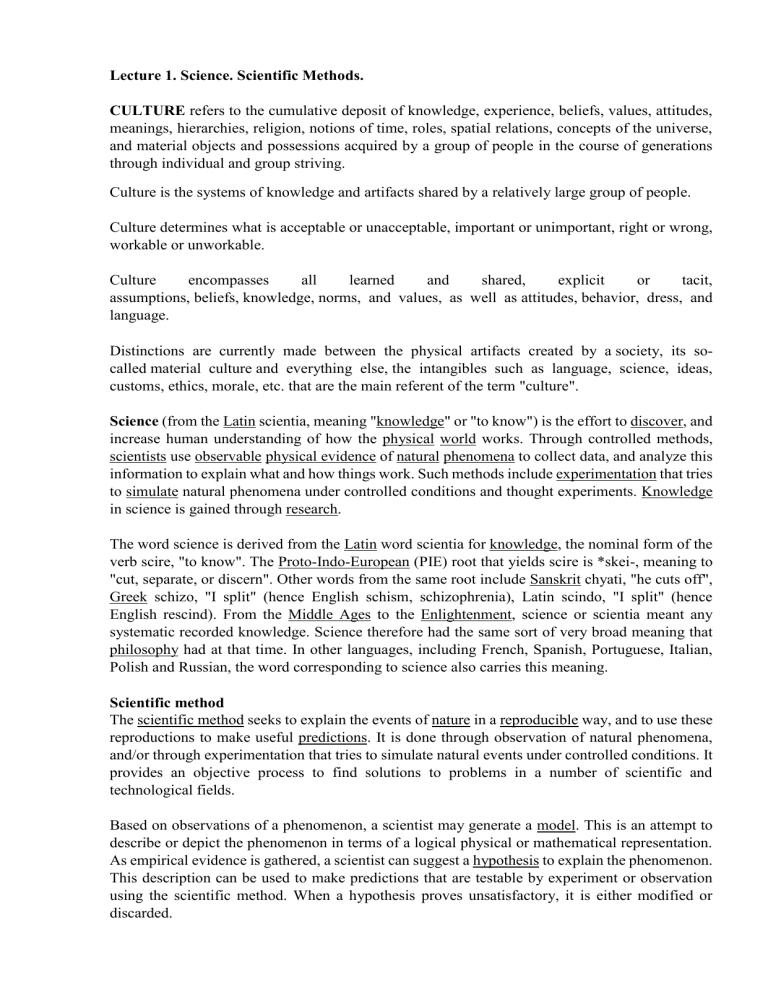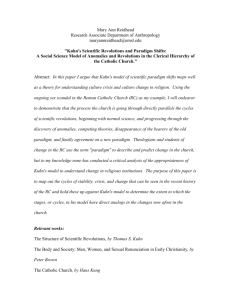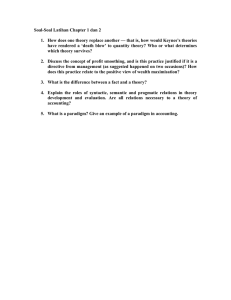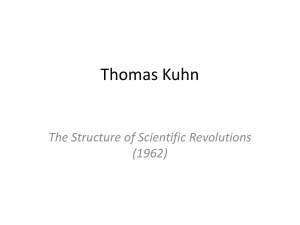
Lecture 1. Science. Scientific Methods. CULTURE refers to the cumulative deposit of knowledge, experience, beliefs, values, attitudes, meanings, hierarchies, religion, notions of time, roles, spatial relations, concepts of the universe, and material objects and possessions acquired by a group of people in the course of generations through individual and group striving. Culture is the systems of knowledge and artifacts shared by a relatively large group of people. Culture determines what is acceptable or unacceptable, important or unimportant, right or wrong, workable or unworkable. Culture encompasses all learned and shared, explicit or tacit, assumptions, beliefs, knowledge, norms, and values, as well as attitudes, behavior, dress, and language. Distinctions are currently made between the physical artifacts created by a society, its socalled material culture and everything else, the intangibles such as language, science, ideas, customs, ethics, morale, etc. that are the main referent of the term "culture". Science (from the Latin scientia, meaning "knowledge" or "to know") is the effort to discover, and increase human understanding of how the physical world works. Through controlled methods, scientists use observable physical evidence of natural phenomena to collect data, and analyze this information to explain what and how things work. Such methods include experimentation that tries to simulate natural phenomena under controlled conditions and thought experiments. Knowledge in science is gained through research. The word science is derived from the Latin word scientia for knowledge, the nominal form of the verb scire, "to know". The Proto-Indo-European (PIE) root that yields scire is *skei-, meaning to "cut, separate, or discern". Other words from the same root include Sanskrit chyati, "he cuts off", Greek schizo, "I split" (hence English schism, schizophrenia), Latin scindo, "I split" (hence English rescind). From the Middle Ages to the Enlightenment, science or scientia meant any systematic recorded knowledge. Science therefore had the same sort of very broad meaning that philosophy had at that time. In other languages, including French, Spanish, Portuguese, Italian, Polish and Russian, the word corresponding to science also carries this meaning. Scientific method The scientific method seeks to explain the events of nature in a reproducible way, and to use these reproductions to make useful predictions. It is done through observation of natural phenomena, and/or through experimentation that tries to simulate natural events under controlled conditions. It provides an objective process to find solutions to problems in a number of scientific and technological fields. Based on observations of a phenomenon, a scientist may generate a model. This is an attempt to describe or depict the phenomenon in terms of a logical physical or mathematical representation. As empirical evidence is gathered, a scientist can suggest a hypothesis to explain the phenomenon. This description can be used to make predictions that are testable by experiment or observation using the scientific method. When a hypothesis proves unsatisfactory, it is either modified or discarded. While performing experiments, Scientists may have a preference for one outcome over another, and it is important that this tendency does not bias their interpretation. A strict following of the scientific method attempts to minimize the influence of a scientist's bias on the outcome of an experiment. This can be achieved by correct experimental design, and a thorough peer review of the experimental results as well as conclusions of a study. Once the experiment results are announced or published, an important cross-check can be the need to validate the results by an independent party. Once a hypothesis has survived testing, it may become adopted into the framework of a scientific theory. This is a logically reasoned, self-consistent model or framework for describing the behavior of certain natural phenomena. A theory typically describes the behavior of much broader sets of phenomena than a hypothesis—commonly, a large number of hypotheses can be logically bound together by a single theory. These broader theories may be formulated using principles such as parsimony (e.g., "Occam's Razor"). They are then repeatedly tested by analyzing how the collected evidence (facts) compares to the theory. When a theory survives a sufficiently large number of empirical observations, it then becomes a scientific generalization that can be taken as fully verified. These assume the status of a physical law or law of nature. Despite the existence of well-tested theories, science cannot claim absolute knowledge of nature or the behavior of the subject or of the field of study due to epistemological problems that are unavoidable and preclude the discovery or establishment of absolute truth. Unlike a mathematical proof, a scientific theory is empirical, and is always open to falsification, if new evidence is presented. Even the most basic and fundamental theories may turn out to be imperfect if new observations are inconsistent with them. Critical to this process is making every relevant aspect of research publicly available, which allows ongoing review and repeating of experiments and observations by multiple researchers operating independently of one another. Only by fulfilling these expectations can it be determined how reliable the experimental results are for potential use by others. Isaac Newton's Newtonian Law of Gravitation is a famous example of an established law that was later found not to be universal—it does not hold in experiments involving motion at speeds close to the speed of light or in close proximity of strong gravitational fields. Outside these conditions, Newton's Laws remain an excellent model of motion and gravity. Since general relativity accounts for all the same phenomena that Newton's Laws do and more, general relativity is now regarded as a more comprehensive theory The great tragedy of science – the slaying of a beautiful hypothesis by an ugly fact. -T.H. Huxley, Biogenesis and Abiogenesis Scientific methods. (Data obtaining, observation, experiment, test, measurement and measurement units, modeling and simulation, statistical processing of data, evaluation, conclusion, incorporation in the current picture). Analysis/Analyses, synthesis, generalization, classification, systematization, unification, comparison and confrontation, grouping, extrapolation, induction, deduction, explanation, clarification, validation, evaluation, standardization, forecast, etc.). Math as the universal language of natural sciences. Logic. Definitions in science and philosophy. Scientific models and idealizations. Progression: Ideas → concepts → hypothesis → theories → paradigm shifts → scientific revolutions. Fundamental laws in philosophy/dialectics (Material vs. Spiritual, Unity and Struggle of Opposites, Quantity Quality Transformation (QQT or Q↨Q), Negation of Negation). PARADIGM A paradigm /ˈpærədaɪm/ is a distinct set of concepts or thought patterns, including theories, research methods, postulates, and standards for what constitutes legitimate contributions to a field. Paradigm comes from Greek παράδειγμα (paradeigma), "pattern, example, sample" from the verb παραδείκνυμι (paradeiknumi), "exhibit, represent, expose" and that from παρά (para), "beside, beyond" and δείκνυμι (deiknumi), "to show, to point out". In rhetoric, paradeigma is known as a type of proof. The purpose of paradeigma is to provide an audience with an illustration of similar occurrences. This illustration is not meant to take the audience to a conclusion, however it is used to help guide them there. A personal accountant is a good comparison of paradeigma to explain how it is meant to guide the audience. It is not the job of a personal accountant to tell their client exactly what (and what not) to spend their money on, but to aid in guiding their client as to how money should be spent based on their financial goals. Anaximenes defined paradeigma as, "actions that have occurred previously and are similar to, or the opposite of, those which we are now discussing." The original Greek term παράδειγμα (paradeigma) was used in Greek texts such as Plato's Timaeus (28A) as the model or the pattern that the Demiurge (god) used to create the cosmos. The term had a technical meaning in the field of grammar: the 1900 Merriam-Webster dictionary defines its technical use only in the context of grammar or, in rhetoric, as a term for an illustrative parable or fable. In linguistics, Ferdinand de Saussure used paradigm to refer to a class of elements with similarities. The Merriam-Webster Online dictionary defines this usage as "a philosophical and theoretical framework of a scientific school or discipline within which theories, laws, and generalizations and the experiments performed in support of them are formulated; broadly: a philosophical or theoretical framework of any kind." Kuhn suggests that certain scientific works, such as Newton's Principia or John Dalton's New System of Chemical Philosophy (1808), provide an open-ended resource: a framework of concepts, results, and procedures within which subsequent work is structured. Normal science proceeds within such a framework or paradigm. A paradigm does not impose a rigid or mechanical approach, but can be taken more or less creatively and flexibly. The Oxford English Dictionary defines the basic meaning of the term paradigm as "a typical example or pattern of something; a pattern or model". The historian of science Thomas Kuhn gave it its contemporary meaning when he adopted the word to refer to the set of practices that define a scientific discipline at any particular period of time. In his book The Structure of Scientific Revolutions Kuhn defines a scientific paradigm as: "universally recognized scientific achievements that, for a time, provide model problems and solutions for a community of practitioners, i.e., what is to be observed and scrutinized the kind of questions that are supposed to be asked and probed for answers in relation to this subject how these questions are to be structured what predictions made by the primary theory within the discipline how the results of scientific investigations should be interpreted how is an experiment to be conducted, and what equipment is available to conduct the experiment. In The Structure of Scientific Revolutions, Kuhn saw the sciences as going through alternating periods of normal science, when an existing model of reality dominates a protracted period of puzzle-solving, and revolution, when the model of reality itself undergoes sudden drastic change. Paradigms have two aspects. Firstly, within normal science, the term refers to the set of exemplary experiments that are likely to be copied or emulated. Secondly, underpinning this set of exemplars are shared preconceptions, made prior to – and conditioning – the collection of evidence. These preconceptions embody both hidden assumptions and elements that he describes as quasimetaphysical; the interpretations of the paradigm may vary among individual scientists. Kuhn was at pains to point out that the rationale for the choice of exemplars is a specific way of viewing reality: that view and the status of "exemplar" are mutually reinforcing. For wellintegrated members of a particular discipline, its paradigm is so convincing that it normally renders even the possibility of alternatives unconvincing and counter-intuitive. Such a paradigm is opaque, appearing to be a direct view of the bedrock of reality itself, and obscuring the possibility that there might be other, alternative imageries hidden behind it. The conviction that the current paradigm is reality tends to disqualify evidence that might undermine the paradigm itself; this in turn leads to a build-up of unreconciled anomalies. It is the latter that is responsible for the eventual revolutionary overthrow of the incumbent paradigm, and its replacement by a new one. Kuhn used the expression paradigm shift (see below) for this process, and likened it to the perceptual change that occurs when our interpretation of an ambiguous image "flips over" from one state to another. (The rabbit-duck illusion is an example: it is not possible to see both the rabbit and the duck simultaneously.) This is significant in relation to the issue of incommensurability (see below). A currently accepted paradigm would be the standard model of physics. The scientific method allows for orthodox scientific investigations into phenomena that might contradict or disprove the standard model; however grant funding would be proportionately more difficult to obtain for such experiments, depending on the degree of deviation from the accepted standard model theory the experiment would test for. To illustrate the point, an experiment to test for the mass of neutrinos or the decay of protons (small departures from the model) is more likely to receive money than experiments that look for the violation of the conservation of momentum, or ways to engineer reverse time travel. Paradigm shifts In The Structure of Scientific Revolutions, Kuhn wrote that "Successive transition from one paradigm to another via revolution is the usual developmental pattern of mature science." (p. 12) Paradigm shifts tend to appear in response to critical anomalies or an accumulation of them as well as the proposal of a new theory with the power to encompass both older relevant data and explain relevant anomalies. New paradigms tend to be most dramatic in sciences that appear to be stable and mature, as in physics at the end of the 19th century. At that time, a statement generally attributed to physicist Lord Kelvin famously claimed, "There is nothing new to be discovered in physics now. All that remains is more and more precise measurement." Five years later, Albert Einstein published his paper on special relativity, which challenged the set of rules laid down by Newtonian mechanics, which had been used to describe force and motion for over two hundred years. In this case, the new paradigm reduces the old to a special case in the sense that Newtonian mechanics is still a good model for approximation for speeds that are slow compared to the speed of light. Philosophers and historians of science, including Kuhn himself, ultimately accepted a modified version of Kuhn's model, which synthesizes his original view with the gradualist model that preceded it. Kuhn's original model is now generally seen as too limited. Kuhn's idea was itself revolutionary in its time, as it caused a major change in the way that academics talk about science. Thus, it may be that it caused or was itself part of a "paradigm shift" in the history and sociology of science. However, Kuhn would not recognize such a paradigm shift. Being in the social sciences, people can still use earlier ideas to discuss the history of science.





